Background
I've been going through John Hughes' Programming with Arrows, and I felt that I had everything straight in my head until the following example of using mapA:
>runSF (mapA (delay 0)) [[1,2,3],[4,5,6],[7,8,9]]
[[0,0,0],[1,2,3],[4,5,6]]
Where runSF extracts the stream function from the StreamFunction arrow defined as:
newtype SF a b = SF {runSF :: [a]->[b]}
And delay is defined as:
delay x = SF (init . (x:))
SF is an instance of ArrowChoice (which declares mapA) and thus an instance of Arrow.
My Understanding
mapA :: arr a b -> arr [a] [b]
delay :: SF a b
such that delay simply prepends its second argument with its first.
Thus, mapA (delay 0) should return us an SF arrow that takes [[a]] and returns [[b]]
mapA (delay 0) :: SF [[a]] [[b]]
I would expect that the "circuit" that this would result in is:

Where the numbers label parts of the process:
- For any non-empty
list x,listcasewill emitRight(x, xs). For the empty list,listcasewill emitLeft(), the terminal case. - Values tagged
Rightwill be passed to the lower portion. Values taggedLeftwill be passed toconst[], which essentially stops the iteration. - With input
(x, xs),xwill be passed to(delay 0), whilexswill be passed back through tolistcase. - The output of 3 will be
(z, zs), which gets passed touncurry (:), which joins the tuple back into the list.
Here’s my understanding of the flow, with input [[1,2,3],[4,5,6],[7,8,9]]:
First pass
Right ([1,2,3],[[4,5,6],[7,8,9]])([1,2,3], [[4,5,6],[7,8,9]])gets passed to the lower portion(delay 0)is called on[1,2,3], resulting in[0,1,2].[[4,5,6],[7,8,9]]is passed back tolistcase
Second pass
Right ([4,5,6], [[7,8,9]])([4,5,6], [[7,8,9]])gets passed to the lower portion(delay 0)is called on[4,5,6], resulting in[0,4,5].[[7,8,9]]is passed back tolistcase
Third pass
Right ([7,8,9], [])([7,8,9], [])gets passed to the lower portion(delay 0)is called on[7,8,9], resulting in[0,7,8].[]is passed back tolistcase.
Fourth pass
Left (), dropped on the floor.
At this point, we get to part 4, which takes the output of 3 and concats it all together. We essentially build of an operation of:
[0,1,2] : [[0,4,5] : [[0,7,8] : []]]
Which would give us [[0,1,2],[0,4,5],[0,7,8]].
My Confusion
Clearly, my above flow is wrong.
How does calling runSF (mapA (delay 0)) [[1,2,3],[4,5,6],[7,8,9]] result in [[0,0,0],[1,2,3],[4,5,6]]?